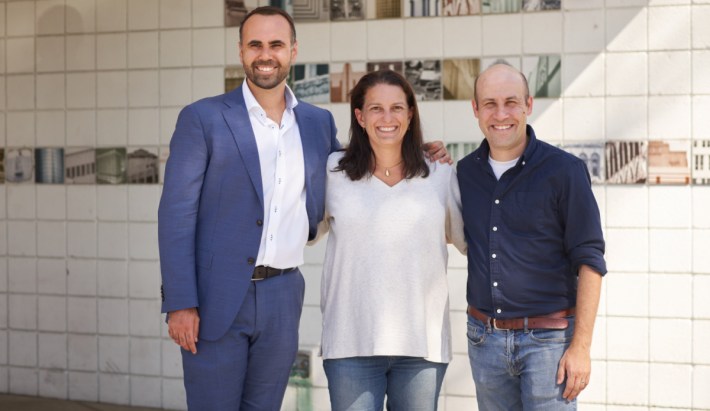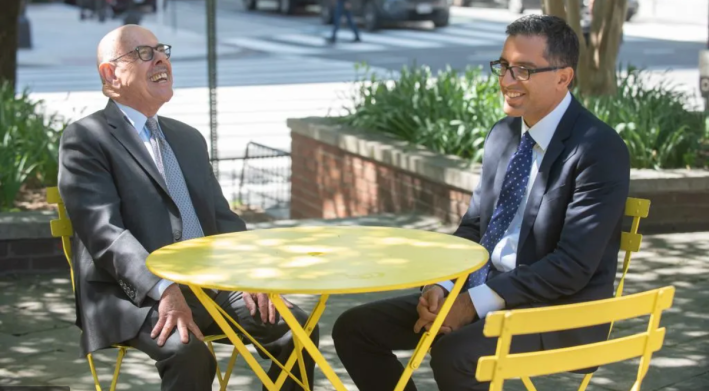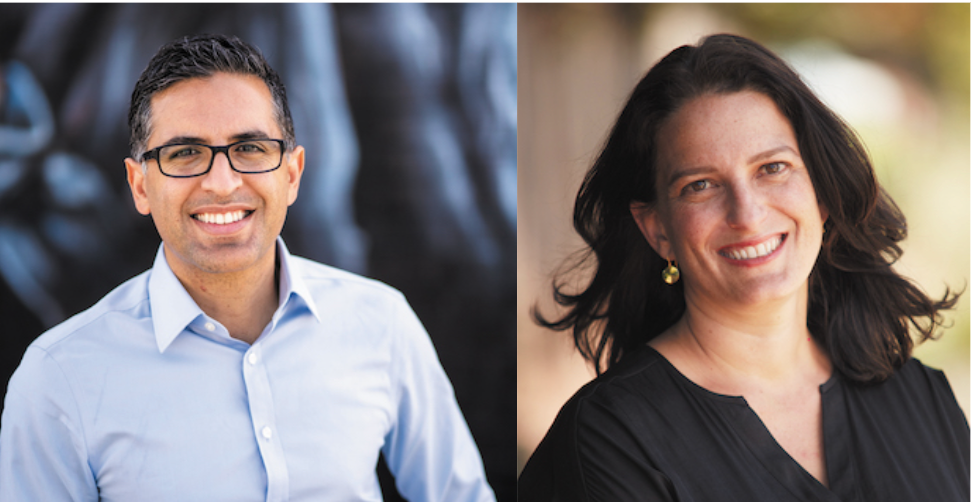Last month, Streetsblog's Damien Newton interviews both of the winners of the L.A. City Council District 5 primary election: Katy Young Yaroslavsky and Sam Yebri. The story below is distilled from those interviews. Interested readers can find the full interviews posted online: Young Yaroslavsky audio or transcript, and Yebri audio or transcript.
When I interviewed Westside City Council candidates Traci Park and Erin Darling in August, I expected there to be clear differences in how their campaigns viewed the major transportation issues in Council District 11. Instead, I found that Darling, an environmentalist through and through and Park, a lover of cycling and sometimes bike commuter, actually shared more similarities than differences on the issues presented. When it came to the CD5 race, I again prepared myself for two candidates who would draw sharp differences between NIMBY and YIMBY style politics but again, I was unprepared.

When it comes to transportation, planning, affordable housing and open space, Sam Yebri and Katy Young Yaroslavsky sound pretty similar. The concept for these interviews was to get the candidates talking about something besides homelessness and policing, the issues that have been the focus of their council races. That idea, while well intentioned, has limited the scope of these articles to allow candidates who are very, very different to appear almost the same. Some of this can be attributed to the conversation around transportation, open space and public health having moved to a far more progressive place than it was a decade ago when Eric Garcetti was first elected mayor.
In CD 5, as in CD 11, the biggest issue in the race is how can the city find ways to reduce the number of unhoused people sleeping and living on the streets, sidewalks and in the parks.
So before I get into the details of how each would support multimodal mobility on Venice Boulevard, open space in Palms, and traffic safety around the Grove, let's touch on homelessness, the city's response to homelessness, and what the candidates have said in other interviews and places. And the biggest difference is how the candidates talk about City Council ordinance 41.18.
41.18 bans people from camping or sleeping within 500 feet of a school, or day care center and to sit, lie or sleep in or upon any street, sidewalk or other public way.
Yebri is very excited about enforcing 41.18 for two reasons. He believes it will, first, increase access to public spaces, such as libraries and parks, by removing the people camping on or near there. And, second, it will create a sense of urgency for people experiencing homelessness to get the help they need.

Given his statements that he doesn't want to see homelessness criminalized, Yebri is placing a lot of faith in homeless outreach services to help people access shelter or interim housing and for a system that is notoriously short on resources to move people into permanent housing (hence slow at opening even temporary beds). The most recent homeless count conducted by L.A. County places the number of people experiencing homelessness in the city of Los Angeles at just under 70,000 people. There are not nearly enough empty beds at shelters and other interim housing locations to provide a roof to 70,000 people.
Young Yaroslavsky is more cautious, but splits the difference between a candidate such as Yebri or Park who fully embrace 41.18 and a candidate such as Darling who rejects it. On her website, Young Yaroslavsky says that an ordinance that just moves people from one block to another doesn't really do anything, but that 41.18 can be used as a 'backstop strategy' when people refuse services or offers of shelter or interim housing.
When it comes to transportation reform, the hot issue in the south part of CD5 is the Venice Boulevard, Safety and Mobility Project that will add new bus lanes and protect existing bike lanes in Palms and Mar Vista in Phase I and all the way to Lincoln Boulevard in Phase II. The area in Palms is in CD5, and both candidates sounded as though they want to see the project move forward. At a meeting in Mar Vista earlier this week, the city Transportation Department (LADOT) announced that Phase I is underway and would be completed quickly, while Phase II was delayed to sometime in 2023.
Yebri noted that some businesses are concerned about losing parking to the protected bike lane, but rather than use that as an excuse to halt the project; Yebri wants to work with businesses to see what can be done to help them.
"...there are also some concerns by some folks who have small businesses nearby about, what about the parking, which I think we can mitigate," Yebri began.
"We can address those concerns. So I’m hopeful that we get to a good place where I’m excited to hopefully support this. We do need protected bike lanes. We need new bus lanes so they aren’t stuck in traffic. They can get people from point A to point B, really fast and that’s not what’s happening right now."
Young Yaroslavsky is excited about the possibility to change the way people use the boulevard, but started to go further by looking at what can be done on the sidewalks as well.
"I recently joined LADOT and the Palms Neighborhood Council for a walk down Venice to really talk about the proposed project. I really appreciate what they’re trying to do here which is to make the road safer for everyone, to incentivize alternative transportation," said Young Yaroslavsky.
"Look, there's not a lot of shade," she said, gesturing from where we were sitting at India Sweets and Spices on Venice Boulevard for our interview. "There’s an opportunity to do more in terms of mixed-use. Making sure we’re not gentrifying, Palms is one of the last remaining affordable-ish affordable neighborhoods in Council District 5."
Yebri also agrees that affordable housing, and the need to preserve it in Palms in particular, is crucial for CD 5 and the city.
"Palms does not get its share of resources and attention from the city and from the Council Office in general," Yebri continued. "For a population of 40,000 Angelenos, there’s one park: Woodbine Park at 1.2 acres. By comparison, Westwood, which has roughly the same population, has 10 times the park space and green space, which is not okay. And, there’s been this real increase in density and gentrification, an increase in rents in Palms and also an increase in crime."
Young Yaroslavsky too noted the lack of open space in CD5 and Palms in particular. She picked the location for our interview because the Palms Neighborhood Council is working to convert an underutilized parking lot next to the Indian grocery store into open space. "Palms only has one park, and that’s insane given the density of the population here now."
When I've done candidate interviews, I've always offered to let the candidates pick the spot for the interview and sometimes they pick spaces that help tell a story that is relevant to their campaign. Yebri picked Espresso Profeta, a coffee shop in Westwood. He sees Westwood Village as a place that could again become one of the great places in all of Los Angeles.
"Westwood Village is really close to my heart. I grew up not too far from here and I really think it shows both the challenges and failures of City Hall and also the opportunities for our great city. So the challenges: 42 percent commercial vacancy rate. So two out of every five storefronts are empty. There is no connected bike lane all the way down to the Expo Line or connecting it elsewhere. That’s a big failure," he said.
"But if you think about what this Village can be, combined with UCLA in Westwood and these neighboring communities, the subway coming… The Village could once again be one of the most wonderful parts of Los Angeles. One of the most vibrant places that is pedestrian-friendly bike-friendly. I have a great plan to turn Westwood Village into that. We’re going to turn Broxton into a pedestrian plaza that’s car-free."
Westwood was not a specific focus of Young Yaroslavsky's interview, although she did mention her support of a bike lane into the village as exists 'on paper' in the city's mobility plan.
Yebri also touched on projects in Television City, in the Pico Neighborhood near the Westside pavilion, and more on a full housing plan that would hopefully bring in low-income housing, workforce housing and eviction protections. Young Yaroslavsky also touched on how fast moving cut-through traffic is endangering all road users in South Carthay, how better outreach could have led to a better Expo Bike Path in Cheviot Hills, how we need to make it easier for families to choose schools that they can walk or bike to.







